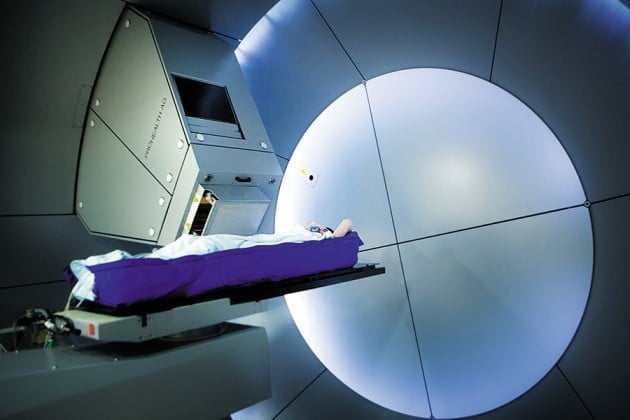Traditional radiation delivers x-rays, or beams of photons, to the tumor and beyond it. This can damage nearby healthy tissues and can cause significant side effects. By contrast, proton therapy delivers a beam of proton particles that stops at the tumor, so it’s less likely to damage nearby healthy tissues.
Ever since then, the procedure has been implemented on nearly two lakhs of people, among which 170,00+ candidates have been successfully cured with the procedure. A high proportion of the candidates belongs to the United States alone where almost 75000 candidates have been successfully treated by the therapy. The success rate of proton therapy is a record-breaking 93.25% which is downright impressive. The therapy is highly appreciated by eminent doctors, surgeons, radiologists owing to its seamless mode of operation and high accuracy. Researchers are constantly trying to make the best out of the procedure so that it can be made both affordable for the common people as well as widely implemented for a number of diseases. In recent decades, proton therapy is expected to emerge as a breakthrough for a number of conditions and diseases.
What is proton therapy?
Better explained as proton beam therapy, the procedure in simple terms, is a focused beam of protons used for destroying the growth of unwanted cells that cause tumor formation. Overgrowth or uncontrolled growth of cells causes the formation of tumors that might be benign or malignant. Proton therapy is used as a replacement for X-Ray therapy and is included as one of the most promising forms of radiation therapy. The procedure implements the usage of proton and focuses it. Thus, a beam of high energy is concentrated into a target place. In medical science, the positive charge photons are focused onto the target tumor which leads to its destruction. Proton therapy is mostly implemented as an advanced mode of cancer treatment. The use of ionization therapy has thus proved to have high accuracy than the previous modes of radiation therapy.
Since the therapy uses highly focused beams, it is used to treat such tumors that are difficult to access. The tumors which are mostly diagnosed in junction with nerves or major organs and need extreme precision are mostly treated with proton therapy. Thus, some of the cases where proton therapy is highly implemented are:
- Pediatric Care
- Skull Cancer (cancer on the basal side)
- Brain Tumors
- Neck Tumor
- Breast Cancer (left-side)
- Prostate Cancer
- Lymphatic Tissue Tumor
- Prostate Tumor
- Hepatocellular Carcinoma
- Gastrointestinal Malignancy
- Reirradiation of Recurrent Cancer
How does it work?
Proton therapy offers an upgraded approach over the traditional photon therapy implemented otherwise. The procedure is preferred over other procedures because of the characteristics of the protons which gives a clinical advantage. The protons can be medically manipulated to achieve distinct dosages to the candidate. Manipulation of the dosages is very important as every tumor expresses different requirements and needs to be treated differently. For example, the dosages for the same tumor are different and need to be manipulated as per the target, distal or proximal.
In this type of external beam radiotherapy, the surgeon shall use a particle accelerator for targeting the tumor with the high-energy beam. The proton beams are sent via a machine that is meant for emitting radiation beams. The beams penetrate through the skin and hit directly at the target position which ensures complete destruction of the tumor. Along with this, the area surrounding the tumor also gets destroyed, which is ideal for containing the overgrowing mass to a specific area. Destruction of the area around the tumor also ensures that the tumor will not spread and the major organs will be saved from any further damage.
This has become possible due to the unique nature of the protons interacting with masses inside the human body. Proton interaction inside the human body portrays a curative solution by concentrating the energy and manipulating the dosages so as to achieve lesser complications and better results.
Conditions for which Proton Therapy is used
Proton therapy is still a subject of research. Even though it has shown immense success in the trials, it is still being researched intensively by researchers all around the world. The implementation of the procedure, however, needs supreme supervision as it involves an extremely high-energy beam for the destruction of cells. Any deviation or any kind of anomaly shall result in complications and irreplaceable damage. Thus, there are certain conditions that should be taken into consideration. Proton therapy is thus suggested in the following cases:
- When the tumor is detected in any part of the nervous system, treating it with a conventional method involves immense risk and is life-threatening in most cases. Thus, to treat it better, the tumor can be destroyed with the help of proton therapy in a seamless way.
- When the tumor clings to a major organ. Many times, tumors (benign or malignant) are detected in the brain or heart, or lungs, in which case operating or performing other forms of radiotherapy becomes difficult and challenging. In such cases, proton therapy is highly suggested as an alternative.
- Eye tumors or malignant lesions can be treated with proton therapy. Operations performed inside the eye involve the risk of rendering the candidate partially or completely blind, in which case, implementing proton therapy gives an easier alternative for both the surgeon and the candidate.
- Proton therapy is also preferred over other conventional methods in case the candidate is diagnosed with breast cancer on the left side. This is because operating on the left side of the breast will pose a serious threat to the nerves and major arteries of the heart and the lungs.
Apart from this, the surgeons have to be extremely careful in choosing the candidate, whether the procedure deems fit or not. The procedure can be performed on candidates in conjunction with other surgical procedures as well. However, for this, the candidate needs to lay still for a period of 30 minutes during which the beam will be focused on the individual in order to destroy the cells and the tissues as required. Besides, the candidate needs to be thoroughly tested for underlying medical conditions which do not interfere with the therapy or create future complications. Although there are very few cases of side effects, yet, every possibility for the same should be ruled out.
Procedure Details
Though the procedure has high success rates, every candidate willing to undergo the procedure should be aware of complete information regarding the procedure as well as how it is going to affect the person undergoing the procedure. One must thoroughly consult the surgeon to understand the risks that might be involved (if any) and the possible follow-up care that will be necessary. The candidate must also understand that irrespective of the efforts, expenditure, time, and exhaustion, the treatment might not yield a completely satisfactory results. Post-procedure result highly depends on the condition of the individual as well as the lifestyle and follow-up care undertaken by the candidate.
A standard proton therapy procedure is performed for a period of five to eight weeks. However, depending on the condition of the tumor being treated, the treatment may proceed for as minimum as two weeks or extend for more than eight weeks. The therapeutic procedure of proton beam therapy is counted as an outpatient service which is provided to the candidates approximately five days every week. The number of days the candidate is exposed to the therapy also may also vary from person to person as it depends on the tumor and the extent to which it is showing growth.
The procedure of Proton Therapy is divided into three sessions which include:
- Stimulation Session: Where the candidate is prepared for the therapy. This included diagnosis and 3D and 4D imaging scans to study the shape, size, and position of the tumor.
- Treatment Session: During this, the initiation of the treatment begins. The candidate is scheduled to have one treatment every week. The side effects are very less which means, the candidate can get back to work after an hour of rest.
- Proton Therapy: The candidate is made to lie down on either the Rotating Machine or the Fixed Machine, where the candidate is exposed to the accelerated high energy beam. Though the treatment lasts approximately for a minute or more, preparing the candidate takes the rest of the time.
Cost of Proton Therapy
Though proton therapy has been gaining ground all over the world, the major issue with availing of the procedure is the cost. No matter how effective the procedure is, not many people are able to avail of the treatment due to the high investment that it involves. On average, proton therapy cost has been estimated to be ranging between $30,000 to $120,000. A number of people resort to alternative radiotherapy methods for two reasons: one involves the lack of exposure to the benefits of the process, and the other is difficulty in affording the procedure. However, the therapy may be covered by some medical insurance, which implies, that if the candidate is in possession of specific insurance which covers the expenses, availing of the procedure becomes much easier.
The reason for the such expense is fairly explainable once we understand the amount of investment it requires for a clinic to install the treatment facility. The clinic or the multispecialty hospital is required to have the necessary infrastructure to house such an extensive procedure, and thus, has to be planned accordingly. Apart from this, the device and the machinery required to project the therapy, along with necessary precautions, is also expensive as in most countries it needs to be imported from the United States. Overall, the expenditure involved to equip as well as establish a suitable therapy center ranges from about $25 million to about $200 million. This is also the reason, why most clinics and most countries prefer other radiation therapies over proton therapy, which makes the procedure less frequently available. However, some of the developed countries as well as the developing countries have come up with lucrative options which are enough to lure suitable candidates to avail themselves of this miraculous procedure. Among them, India, Turkey, Spain, Switzerland, Lithuania, Singapore, and Malaysia top the list. Thus, here is a brief insight on the proton therapy cost one has to incur in different countries all around the world:
Proton Therapy in India
Among the various countries in the world, India is known to offer proton therapy in the most affordable packages across the world. The country has made its mark in the field of medical science since time immemorial. From herbs to chemicals, traditional to advanced, medical science in India flaunts an outstanding success record that drives thousands of medical tourists to the country every year. The treatment facility in India is more advanced than most of the countries in the world. However, uncompromised diagnosis and treatment options are available in some of the cheapest packages on a global scale. On average, the proton therapy cost in India has been estimated to vary from $14,490 to approximately $28,819 which is counted among the lowest packages offered around the world. The reason is, the clinics in India are designed to accommodate highly efficient devices, even the ones involving high energy beam radiations, i.e., radiation therapies alike. Thus, most part of the expense revolves around accommodating the devices. Apart from this, the clinics offering proton therapy are known to house world-class medical professionals who are trained to perform radiation therapies with excellent accuracy. The surgeons and radiologists performing the procedure are highly skilled professionals who have earned distinct training in the field and are thus, well-acquainted with their jobs. Medical professionals are thereby praised for their exceptional skills in dealing with simple with complex procedures.







